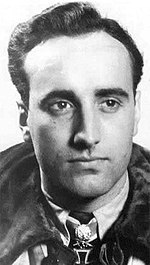
Back هاينز فولفجانج شناوفر Arabic هينز ولفجانج ستشناوفير ARZ Heinz-Wolfgang Schnaufer Czech Heinz-Wolfgang Schnaufer German Heinz-Wolfgang Schnaufer Spanish هاینتس-ولفگانگ شناوفر Persian Heinz-Wolfgang Schnaufer Finnish Heinz-Wolfgang Schnaufer French היינץ וולפגנג שנאופר HE Heinz-Wolfgang Schnaufer Hungarian
Heinz-Wolfgang Schnaufer | |
|---|---|
 Schnaufer wearing the Diamonds to his Knight's Cross | |
| Nickname(s) | Spook of Sint-Truiden |
| Born | 16 February 1922 Calw, Württemberg, Weimar Germany |
| Died | 15 July 1950 (aged 28) Bordeaux, France |
| Buried | Calw, Village Cemetery |
| Allegiance | |
| Service/ | |
| Years of service | 1939–45 |
| Rank | Major (major) |
| Unit | NJG 1, NJG 4 |
| Commands held | 12./NJG 1, IV./NJG 1, NJG 4 |
| Battles/wars | |
| Awards | Knight's Cross of the Iron Cross with Oak Leaves, Swords and Diamonds |
| Other work | Wine business |
Heinz-Wolfgang Schnaufer (16 February 1922 – 15 July 1950) was a German Luftwaffe night-fighter pilot and the highest-scoring night fighter ace in the history of aerial warfare. A flying ace is a military aviator credited with shooting down five or more enemy aircraft during combat.[1] All Schnaufer's 121 victories were claimed during World War II, mostly against British four-engine bombers,[Note 1] for which he was awarded the Knight's Cross of the Iron Cross with Oak Leaves, Swords and Diamonds, Germany's highest military decoration at the time, on 16 October 1944.[Note 2] He was nicknamed "The Spook of St. Trond", from the location of his unit's base in occupied Belgium.
Born in Calw, Schnaufer grew up in the Weimar Republic and Nazi Germany. Already a glider pilot at school, he began military service in the Wehrmacht by joining the Luftwaffe in 1939. After training at various pilot and fighter-pilot schools, he was posted to Nachtjagdgeschwader 1 (NJG 1—1st Night Fighter Wing), operating on the Western Front, in November 1941. He flew his first combat sorties in support of Operation Cerberus, the breakout of the German ships Scharnhorst, Gneisenau, and Prinz Eugen from Brest. Schnaufer participated in the Defence of the Reich campaign from 1942 onwards, in which he would achieve most of his success. He claimed his first aerial victory on the night of 1/2 June 1942. As the war progressed, he accumulated further victories and later became a squadron leader and group commander. He was awarded the Knight's Cross of the Iron Cross on 31 December 1943 for reaching 42 aerial victories.
Schnaufer achieved his 100th aerial victory on 9 October 1944 and was awarded the Diamonds to his Knight's Cross of the Iron Cross with Oak Leaves and Swords on 16 October. He was appointed Geschwaderkommodore (wing commander) of Nachtjagdgeschwader 4 (NJG 4) on 4 November. By the end of hostilities, Schnaufer's night-fighter crew held the unique distinction that every member—radio operator and air gunner—was decorated with the Knight's Cross of the Iron Cross. Schnaufer was taken prisoner of war by British forces in May 1945. After his release a year later, he returned to his home town and took over the family wine business. He sustained injuries in a road accident on 13 July 1950 during a wine-purchasing visit to France, and died in a Bordeaux hospital two days later.
- ^ Spick 1996, pp. 3–4.
- ^ Williamson & Bujeiro 2004, pp. 3, 7.
Cite error: There are <ref group=Note> tags on this page, but the references will not show without a {{reflist|group=Note}} template (see the help page).